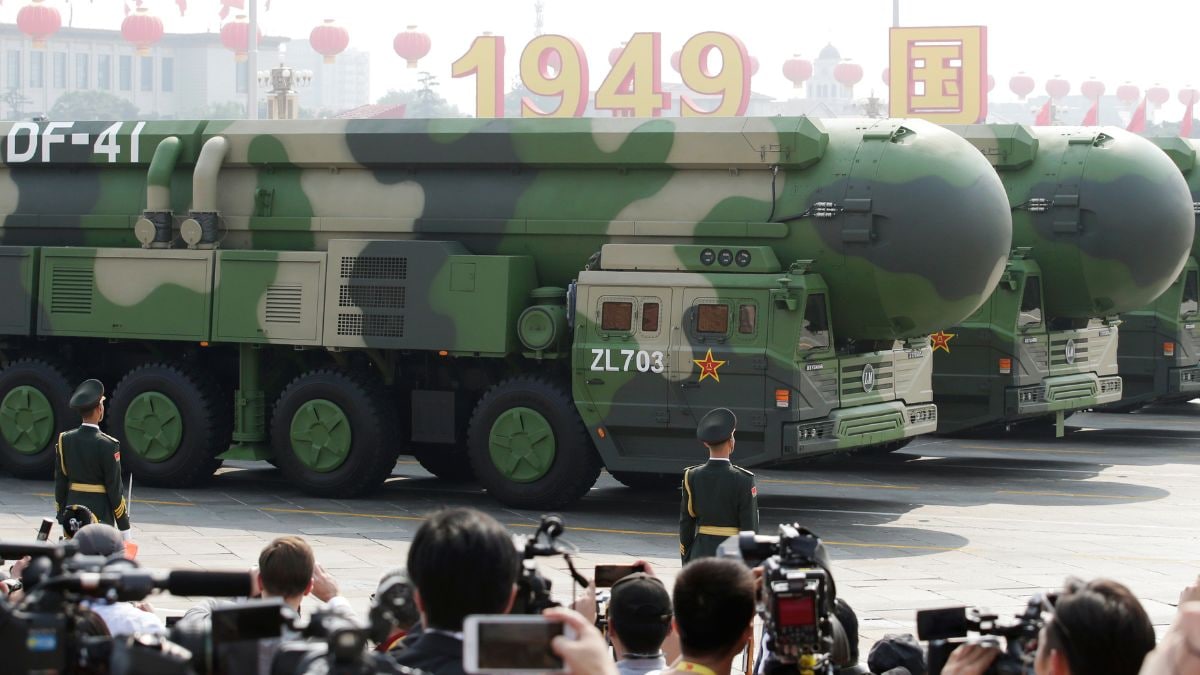China is set to display its DF-41 intercontinental ballistic missile (ICBM) at the upcoming military parade on September 3, 2025, marking the 80th anniversary of Victory over Japan and the end of World War II. This has inevitably led to comparisons with India's BrahMos supersonic cruise missile, raising questions about how these two systems stack up against each other.
DF-41: A Global Strategic Weapon
The DF-41 (Dongfeng-41) is a road-mobile, solid-fueled ICBM that represents the fourth and latest generation of Dongfeng series strategic missiles developed by China. It is one of the most dangerous ICBMs in the world. Here's a look at its key features:
- Range: The DF-41 has an estimated operational range of 12,000 to 15,000 kilometers. This allows it to strike targets across the globe, including the continental United States.
- Payload: It can carry a payload of up to 1,000 kg, including 10 to 12 independently targetable warheads (MIRVs). Some analysts believe it carries three warheads with additional payload for penetration aids.
- Speed: The missile can reach a maximum speed of Mach 25. This hypersonic speed, combined with its maneuverability, makes it difficult to intercept. It could reach the U.S. in 20 to 30 minutes.
- Accuracy: The DF-41 uses an inertial guidance system, likely with stellar updates and a Global Positioning Satellite (GPS) system, providing an accuracy of 100-500 m CEP (circular error probable). Some sources claim an accuracy of ~100m CEP.
- Mobility: The DF-41 is launched from a road-mobile transporter erector launcher (TEL), which enhances its survivability by making it difficult to target. China is also exploring silo-basing and train-based launch systems for the DF-41.
BrahMos: A Versatile Tactical Weapon
The BrahMos is a supersonic cruise missile developed jointly by India's Defence Research and Development Organisation (DRDO) and Russia's NPO Mashinostroyeniya. It is named after the Brahmaputra and Moskva rivers. Key features include:
- Range: The BrahMos has a range of up to 800 kilometers.
- Speed: It is a supersonic cruise missile with a speed of Mach 2.8 to 3. A hypersonic version, BrahMos-II, is under development and is projected to reach speeds exceeding Mach 6 with a range of 1,500km.
- Payload: It can carry a warhead of up to 300 kg and is capable of destroying strong structures or targets.
- Accuracy: The BrahMos is known for its precision strike capabilities, with a circular error probable (CEP) of less than 1 meter.
- Versatility: The BrahMos can be launched from various platforms, including land-based mobile launchers, ships, submarines, and aircraft.
- Advanced Technology: It incorporates advanced technology, including high speed, a low-flying trajectory, and evasive maneuvers, making interception challenging.
DF-41 vs. BrahMos: A Comparison
It is not appropriate to compare the BrahMos to the DF-41 in terms of strength, as the BrahMos is a cruise missile. Here's a comparison of the two missiles based on their capabilities:
- Type: The DF-41 is an intercontinental ballistic missile (ICBM), while the BrahMos is a supersonic cruise missile. This fundamental difference in design dictates their roles and capabilities.
- Range and Strategic Role: The DF-41's long range and MIRV capability make it a strategic weapon designed for nuclear deterrence and striking targets across continents. The BrahMos, with its shorter range, is a tactical weapon intended for precision strikes within a specific region.
- Speed: Both missiles are fast, with the DF-41 reaching hypersonic speeds during the terminal phase of its flight, while the BrahMos maintains supersonic speeds throughout its flight.
- Mission: The DF-41 is designed to strike targets at intercontinental ranges, while the BrahMos is designed for regional conflicts.
- Geopolitical Impact: The DF-41 is intended to achieve global strategic balance, while the BrahMos's potential deployment aims to enhance India's role in regional geopolitics.
Conclusion
The DF-41 and BrahMos serve different purposes and operate in different strategic contexts. The DF-41 is a strategic nuclear weapon designed for intercontinental strikes, while the BrahMos is a versatile tactical weapon for regional conflicts. The upcoming display of the DF-41 at China's military parade highlights its significance in China's strategic arsenal, while the BrahMos continues to enhance India's regional deterrence capabilities and is being exported to strengthen defense partnerships.

